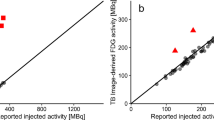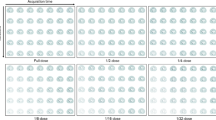Abstract
Purpose
In PET/CT imaging, the activity of the 18F-FDG activity is injected either based on patient body weight (BW) or body mass index (BMI). The purpose of this study was to optimise BMI-based whole body 18F-FDG PET images obtained from overweight and obese patients and assess their image quality, quantitative value and radiation dose in comparison to BW-based images.
Methods
The NEMA-IEC-body phantom was scanned using the mCT 128-slice scanner. The spheres and background were filed with F-18 activity. Spheres-to-background ratio was 4:1. Data was reconstructed using the OSEM-TOF-PSF routine reconstruction. The optimization was performed by varying number of iterations and subsets, filter’s size and type, and matrix size. The optimized reconstruction was applied to 17 patients’ datasets. The optimized BMI-, routine BMI- and the BW-based images were compared visually and using contrast-to-noise ratio (CNR) and standardized uptake values (SUV) measurements.
Results
The visual assessment of the optimized phantom images showed better image quality and contrast-recovery-coefficients (CRCs) values compared to the routine reconstruction. Using patient data, the optimized BMI-based images provided better image quality compared to BW-based images in 87.5% of the overweight cases and 66.7% for obese cases. The optimized BMI-based images resulted in more than 50% reduction of radiation dose. No significant differences were found between the three series of images in SUV measurements.
Conclusion
The optimized BMI-based approach using 1 iteration, 21 subsets, and 3 mm Hamming filter improves image quality, reduces radiation dose, and provides, at least, similar quantification compared to the BW-based approach for overweight and obese patients.









Similar content being viewed by others
Data Availability
The datasets generated during and/or analysed during the current study are available in our local PACS storage system.
Code Availability
The Siemens Syngo.via reporting and processing workstation was used.
References
Delbeke D, Coleman RE, Guiberteau MJ, Brown ML, Royal HD, Siegel BA, et al. Procedure guideline for tumor imaging with 18F-FDG PET/CT 1.0. J Nucl Med. 2006;47(5):885–95.
Weber WA. Use of PET for monitoring cancer therapy and for predicting outcome. J Nucl Med. 2005;46:983–95.
Hoekstra CJ, Hoekstra OS, Stroobants SG, Vansteenkiste J, Nuyts J, Smit EF, et al. Methods to monitor response to chemotherapy in non-small cell lung cancer with 18F-FDG PET. J Nucl Med. 2002;43:1304–9.
Boellaard R, Delgado-Bolton R, Oyen WJG, Giammarile F, Tatsch K, Eschner W, et al. FDG PET/CT: EANM procedure guidelines for tumour imaging: version 2.0. Eur J Nucl Med Mol Imaging. 2015;42(2):328–54.
Boellaard R, O’Doherty MJ, Weber WA, Mottaghy FM, Lonsdale MN, Stroobants SG, et al. FDG PET and PET/CT: EANM procedure guidelines for tumour PET imaging: Version 1.0. Eur J Nucl Med Mol Imaging. 2010;37(1):181–200.
Kobe C, Dietlein M, Franklin J, Markova J, Lohri A, Amthauer H, et al. Positron emission tomography has a high negative predictive value for progression or early relapse for patients with residual disease after first-line chemotherapy in advanced-stage Hodgkin lymphoma. Blood. 2008;112(10):3989–94.
Barrington SF, Mikhaeel NG, Kostakoglu L, Meignan M, Hutchings M, Müeller SP, et al. Role of imaging in the staging and response assessment of lymphoma: consensus of the international conference on malignant lymphomas imaging working group. J Clin Oncol. 2014;32(27):3048–58.
Ido T, Wan C-N, Casella V, Fowler JS, Wolf AP, Reivich M, et al. Labeled 2-deoxy-D-glucose analogs. 18F-labeled 2-deoxy-2-fluoro-D-glucose, 2-deoxy-2-fluoro-D-mannose and 14C-2-deoxy-2-fluoro-D-glucose. J Label Compd Radiopharm. 1978;14(2):175–83.
Warburg O. Über den Stoffwechsel der Carcinomzelle. Naturwissenschaften. 1924;12:1131–7.
Kuhnert G, Boellaard R, Sterzer S, Kahraman D, Scheffler M, Wolf J, et al. Impact of PET/CT image reconstruction methods and liver uptake normalization strategies on quantitative image analysis. J Nucl Med Mol Imaging. 2016;43(2):249–58.
Tatsumi M, Clark PA, Nakamoto Y, Wahl RL. Impact of body habitus on quantitative and qualitative image quality in whole-body FDG-PET. Eur J Nucl Med Mol Imaging. 2003;30(1):40–5.
Boldyš J, Dvořák J, Skopalová M, Bělohlávek O. Monte Carlo simulation of PET images for injection dose optimization. Int J Numer Method Biomed Eng. 2013;29(9):988–99.
Halpern BS, Dahlbom M, Auerbach MA, Schiepers C, Fueger BJ, Weber WA, et al. Optimizing imaging protocols for overweight and obese patients: a lutetium orthosilicate PET/CT study. J Nucl Med. 2005;46:603–7.
Physical status: the use and interpretation of anthropometry. Report of a WHO Expert Committee. World Health Organ Tech Rep Ser. 1995;854:1–452
Donato KA. Executive summary of the clinical guidelines on the identification, evaluation, and treatment of overweight and obesity in adults. Arch Intern Med. 1998;158(17):1855–67.
Masuda Y, Kondo C, Matsuo Y, Uetani M, Kusakabe K. Comparison of imaging protocols for 18F-FDG PET/CT in overweight patients: optimizing scan duration versus administered dose. J Nucl Med. 2009;50(6):844–8.
Nagaki A, Onoguchi M, Matsutomo N. Patient weight-based acquisition protocols to optimize18F-FDG PET/CT image quality. J Nucl Med Technol. 2011;39(2):72–6.
Krumrey S, Isaac T, Yost P, Oliver D, Nguyen N, Medhat O, et al. Should FDG dose be based on BMI instead of body weight? J Nucl Med. 2010;49:415.
Sánchez-Jurado R, Devis M, Sanz R, Aguilar JE, del Puig CM, Ferrer-Rebolleda J. Whole-body PET/CT studies with lowered 18F-FDG doses: the influence of body mass index in dose reduction. J Nucl Med Technol. 2014;42(1):62–7.
Janabi M, Kumar A, Muzik O. Body mass index (BMI) adjusted 18F-FDG dose to reduce radiation exposure. J Nucl Med. 2013;54:92.
Akamatsu G, Mitsumoto K, Ishikawa K, Taniguchi T, Ohya N, Baba S, et al. Benefits of point-spread function and time of flight for PET/CT image quality in relation to the body mass index and injected dose. Clin Nucl Med. 2013;38(6):407–12.
Taniguchi T, Akamatsu G, Kasahara Y, Mitsumoto K, Baba S, Tsutsui Y, et al. Improvement in PET/CT image quality in overweight patients with PSF and TOF. Ann Nucl Med. 2015;29(1):71–7.
Saha GB. Basics of PET imaging: Physics, chemistry, and regulations. 3rd ed. Springer; 2015.
Oliveira CM, Silva TA da, Vieira IF, Lima FRA, Vieira JW, Sa LV de. Characterization of a PET-NEMA/IEC body phantom for quality control tests of PET/CT equipment. 2011. https://inis.iaea.org/collection/NCLCollectionStore/_Public/43/056/43056338.pdf?r=1. Accessed 25 Oct 2020.
Gupta A, Sharma P, Patel CD, Maharjan S, Pandey A, Kumar R, Malhotra A. Size-dependent thresholding as an optimal method for tumor volume delineation on positron emission tomography-computed tomography: a Phantom study. Indian J Nucl Med. 2011;26(1):22–6. https://doi.org/10.4103/0972-3919.84598.
Rausch I, Cal-González J, Dapra D, Gallowitsch HJ, Lind P, Beyer T, et al. Performance evaluation of the Biograph mCT Flow PET/CT system according to the NEMA NU2-2012 standard. EJNMMI Phys. 2015;2(1):26.
Alessio AM, Stearns CW, Tong S, Ross SG, Kohlmyer S, Ganin A, et al. Application and evaluation of a measured spatially variant system model for PET image reconstruction. IEEE Trans Med Imaging. 2010;29(3):938–49.
Aide N, Lasnon C, Veit-Haibach P, Sera T, Sattler B, Boellaard R. EANM/EARL harmonization strategies in PET quantification: from daily practice to multicentre oncological studies. Eur J Nucl Med Mol Imaging. 2017;44(Suppl 1):17–31.
Kaalep A, Sera T, Oyen W, Krause BJ, Chiti A, Liu Y, et al. EANM/EARL FDG-PET/CT accreditation - summary results from the first 200 accredited imaging systems. Eur J Nucl Med Mol Imaging. 2018;45(3):412–22.
Seung JL, Hoon-Hee P, Han-Sang L, Jae SK, Chang HL. Comparison of imaging protocols for 18F-FDG PET/CT in calculation of injection dose: body weight versus body mass index. J Nucl Med. 2010;51(2):2070.
Yan J, Schaefferkoetter J, Conti M, et al. A method to assess image quality for Low-dose PET: analysis of SNR, CNR, bias and image noise. Cancer Imaging. 2016;16(1):26.
Ceriani L, Suriano S, Ruberto T, Zucca E, Giovanella L. 18F-FDG uptake changes in liver and mediastinum during chemotherapy in patients with diffuse large B-cell lymphoma. Clin Nucl Med. 2012;37(10):949–52.
Kim SJ, Yi HK, Lim CH, Cho YS, Choi JY, Choe YS, et al. Intra-patient variability of FDG standardized uptake values in mediastinal blood pool, liver, and myocardium during R-CHOP chemotherapy in patients with diffuse large B-cell lymphoma. Nucl Med Mol Imaging. 2016;50(4):300–7.
Boktor RR, Walker G, Stacey R, Gledhill S, Pitman AG. Reference range for intrapatient variability in blood-pool and liver SUV for 18F-FDG PET. J Nucl Med. 2013;54(5):677–82.
Bouchareb Y, Thielemans K, Spinks T, Rimoldi O, Camici PG. Comparison of analytic and iterative reconstruction methods for quantitative cardiac PET studies in 3D using oxygen-15 water scans. IEEE Nucl Sci Symp Conf Rec. 2005. https://doi.org/10.1109/NSSMIC.2005.1596753.
Chilcott AK, Bradley KM, McGowan DR. Effect of a Bayesian penalized likelihood PET reconstruction compared with ordered subset expectation maximization on clinical image quality over a wide range of patient weights. AJR Am J Roentgenol. 2018;210(1):153–7.
Author information
Authors and Affiliations
Contributions
The study conception and design were performed by Yassine Bouchareb and Naima Tag. Material preparation, data collection and analysis were performed by Yassine Bouchareb, Hajir Sulaiman and Naima Tag. The assessment of phantom and clinical images was carried out by Naima Tag, Khulood Al-Riyami and Zabah Jawa. The first draft of the manuscript was written by Yassine Bouchareb and Hajir Sulaiman and all authors commented on previous versions of the manuscript. All authors read and approved the final manuscript.
Corresponding author
Ethics declarations
Conflict of Interest
Yassine Bouchareb, Naima Tag, Hajir Sulaiman, Khulood Al-Riyami, Zabah Jawa, and Humoud Al-Dhuhli declare that they have no conflict of interest.
Ethics Approval and Consent to Participate
The study was approved by the Research Ethics Committee of college of medicine and health sciences, Sultan Qaboos University (ethics approval certificate can be sent upon request). As per the policy of our institution, the ethical approval of retrospective studies grants the use of patients’ data in clinical research projects (no consent to participate is required). Patients’ scans used in the study were part of the routine care, and were in accordance with the Helsinki declaration as revised in 2013 and its later amendments.
Consent for Publication
As per the policy of our institution, the ethical approval of retrospective studies grants the use of non-identifiable patients’ data in papers for publication.
Additional information
Publisher's Note
Springer Nature remains neutral with regard to jurisdictional claims in published maps and institutional affiliations.
Rights and permissions
Springer Nature or its licensor (e.g. a society or other partner) holds exclusive rights to this article under a publishing agreement with the author(s) or other rightsholder(s); author self-archiving of the accepted manuscript version of this article is solely governed by the terms of such publishing agreement and applicable law.
About this article
Cite this article
Bouchareb, Y., Tag, N., Sulaiman, H. et al. Optimization of BMI-Based Images for Overweight and Obese Patients — Implications on Image Quality, Quantification, and Radiation Dose in Whole Body 18F-FDG PET/CT Imaging. Nucl Med Mol Imaging 57, 180–193 (2023). https://doi.org/10.1007/s13139-023-00795-5
Received:
Revised:
Accepted:
Published:
Issue Date:
DOI: https://doi.org/10.1007/s13139-023-00795-5




